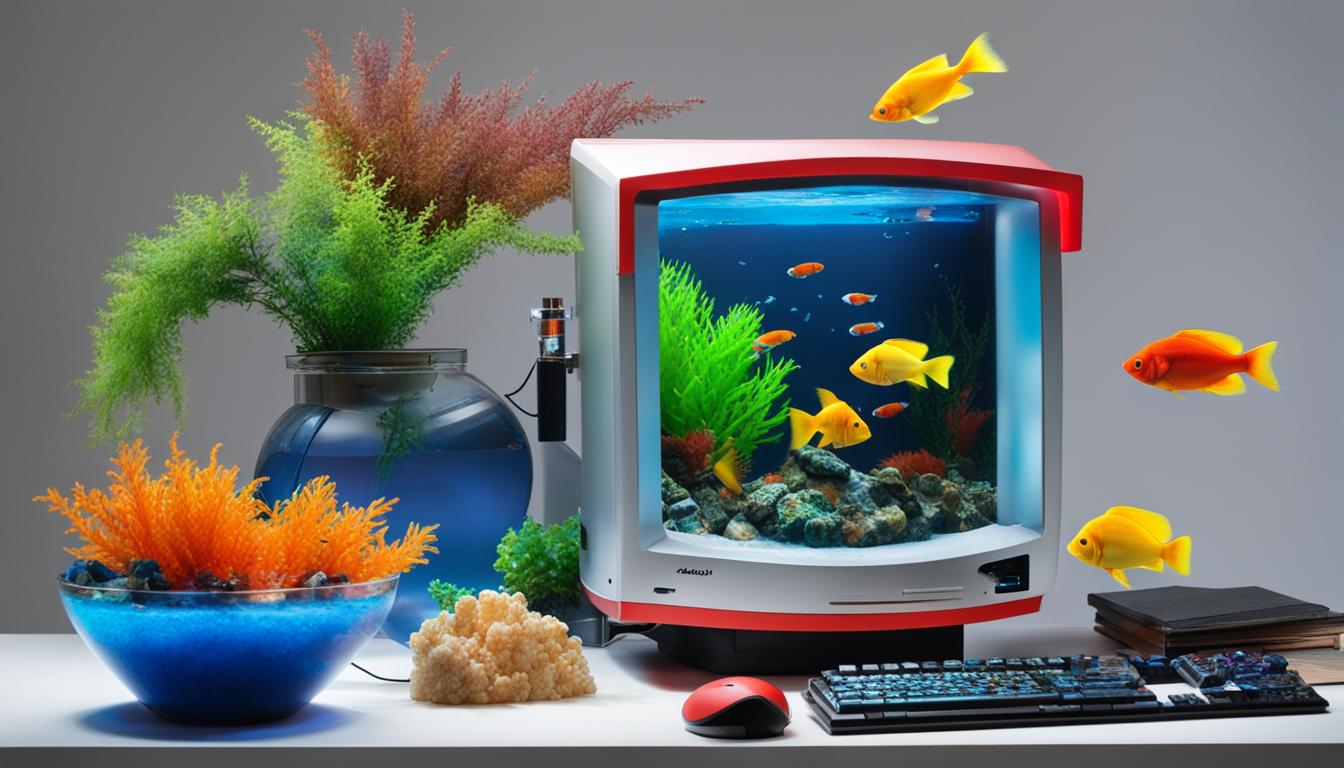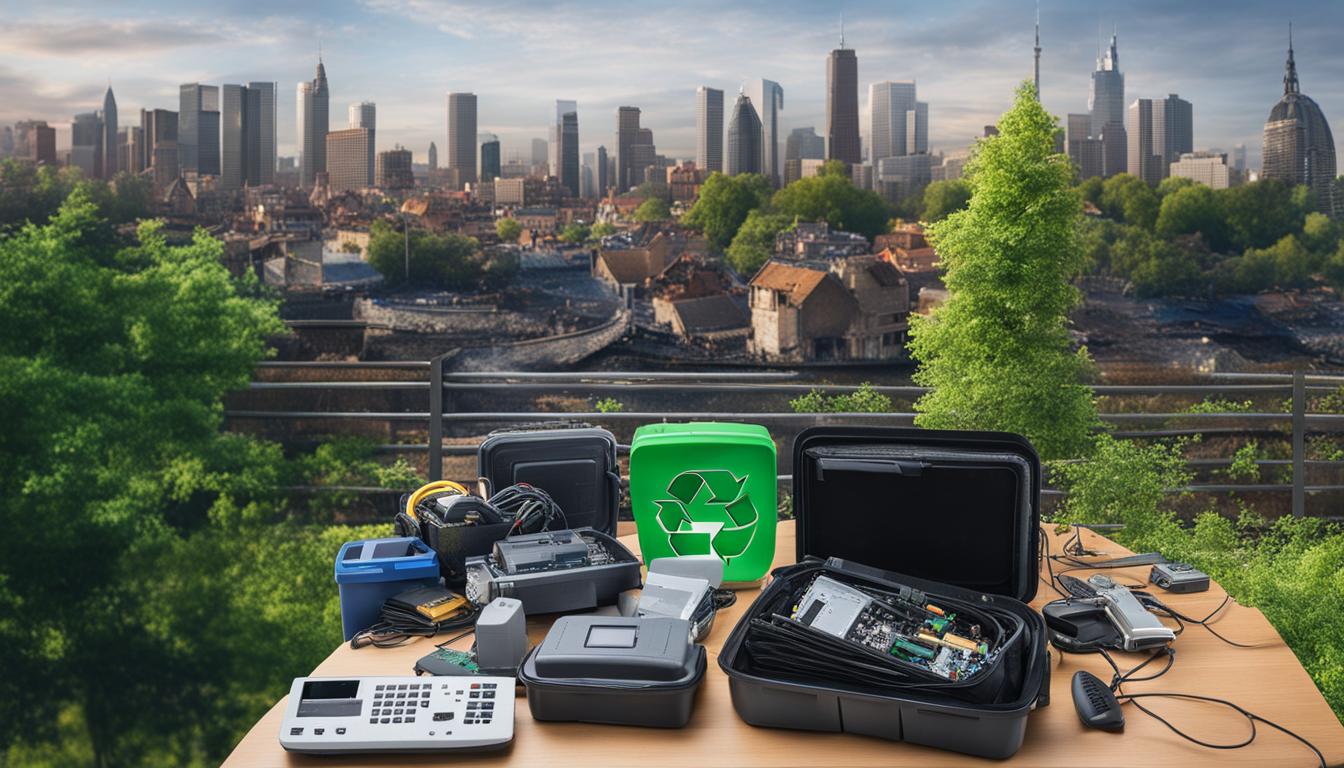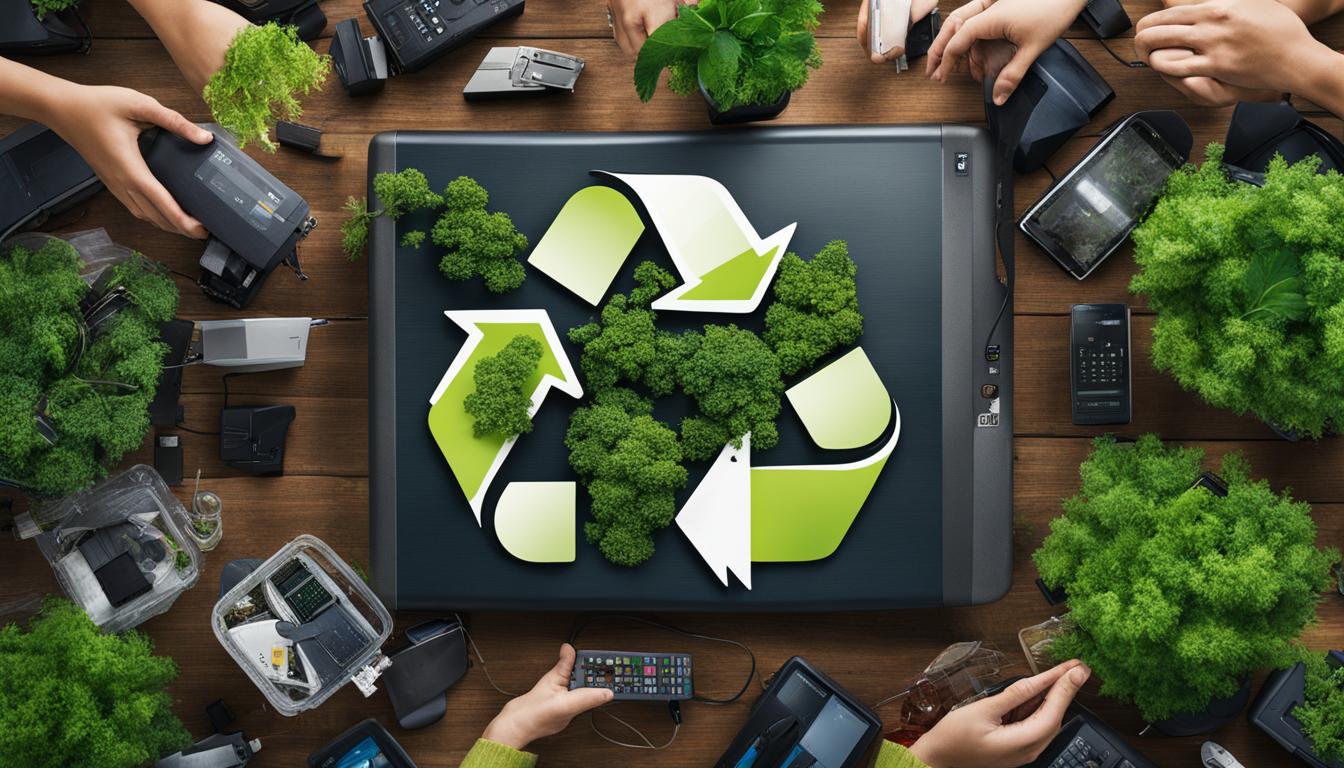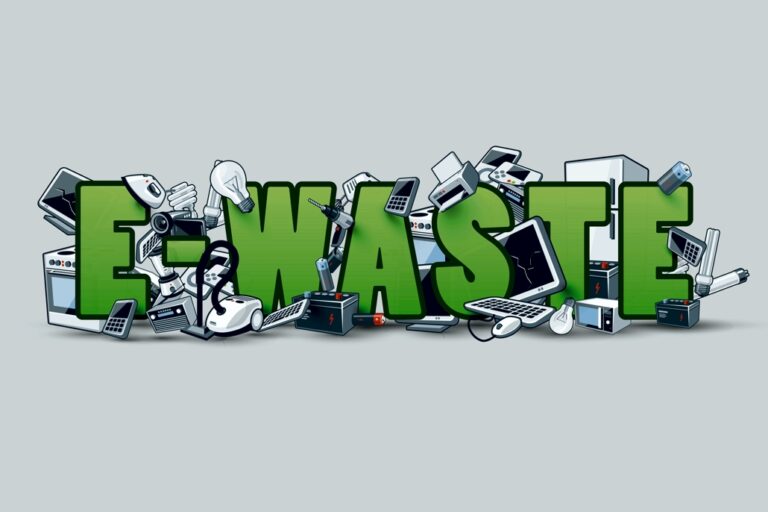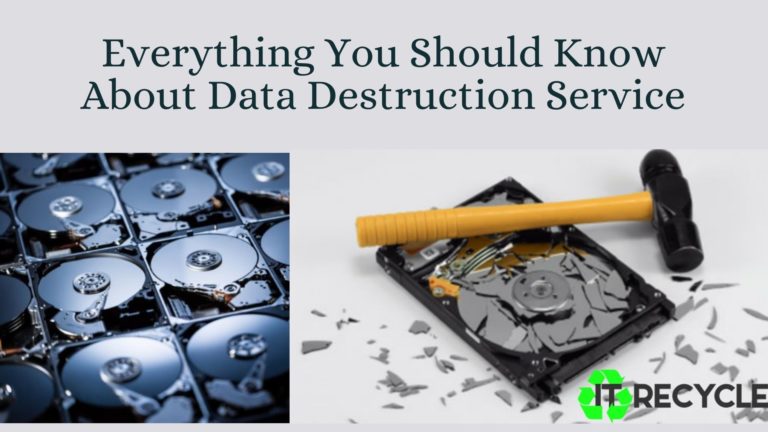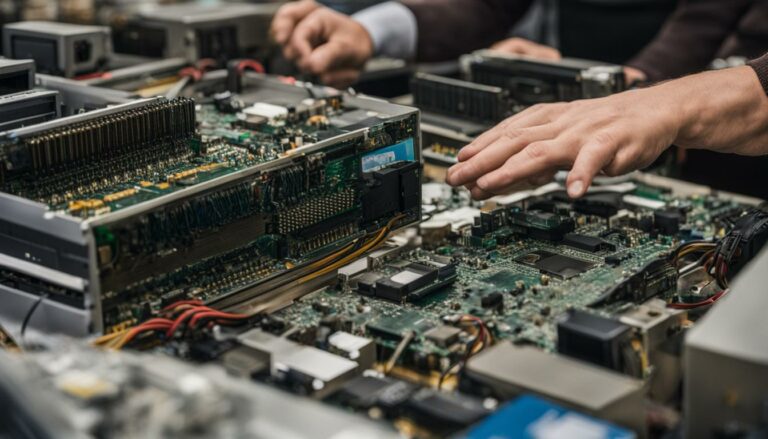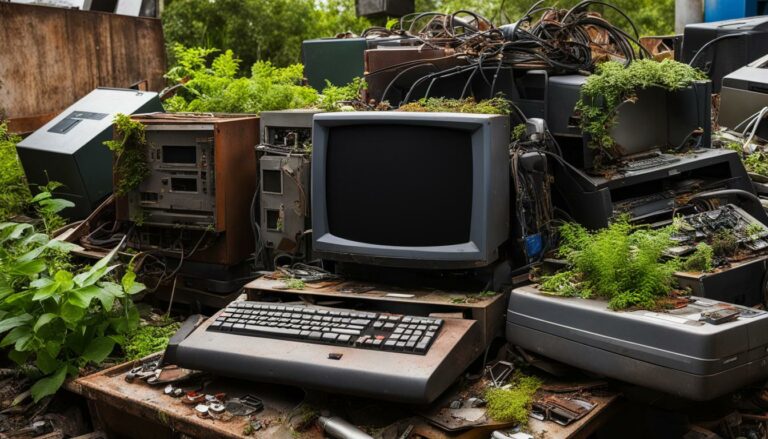From Trash to Treasure: Repurposed IT Equipment Stories
Repurposed IT equipment is more than just old machines. It’s about preserving the history of personal computing, making new discoveries, and embracing sustainability. Vintage computers have their own stories and are sought after by enthusiasts. The demand for repurposed IT equipment is rising as people recognise the importance of recycling and sustainable practices. Many individuals and businesses are finding value in refurbished technology and pre-owned tech gear. By repurposing IT equipment, we can extend its lifespan and reduce electronic waste.
Key Takeaways
- Repurposed IT equipment offers a sustainable solution for reducing electronic waste.
- There is a growing demand for refurbished technology and pre-owned tech gear.
- Starting a repurposed IT equipment business requires careful planning and understanding of regulations.
- The industry faces challenges such as fluctuating availability of recyclable materials and technological advancements.
- Micro-factories for repurposed IT equipment show promise in decentralizing recycling and creating new business models.
The Growing Market for Repurposed IT Equipment
The recycling industry is evolving, driven by the increasing demand for sustainable practices and the potential for financial profitability. The amount of e-waste generated worldwide has doubled in recent years, with the resources embedded in that waste estimated to be worth billions of pounds. However, less than one-sixth of e-waste is properly recycled. In the UK, the demand for recycled IT products is expected to rise as more individuals and businesses adopt eco-conscious behaviour. Repurposed IT equipment offers a sustainable and cost-effective solution for those looking for refurbished technology and used computer hardware.
According to a recent study, the market for repurposed IT equipment is projected to grow at a CAGR of 7.4% from 2021 to 2026. This growth is attributed to several factors, including the increasing awareness of the environmental impact of electronic waste and the rising need for affordable technology solutions. Repurposed IT equipment provides an opportunity to extend the lifespan of devices and reduce electronic waste, supporting the transition towards a more circular economy.
The market for repurposed IT equipment spans across various sectors, including education, healthcare, finance, and small businesses. These sectors are recognizing the value of sustainable computing solutions and the cost-saving benefits of repurposed technology. By investing in refurbished IT equipment and used computer hardware, organizations can contribute to a more environmentally friendly approach while enjoying the performance and functionality of reliable IT devices.
| Key Benefits of Repurposed IT Equipment | Key Challenges of Repurposed IT Equipment |
|---|---|
|
|
“Repurposed IT equipment provides a win-win situation for both businesses and the environment. By investing in refurbished technology, companies can reduce their carbon footprint while accessing cost-effective solutions.”
The growing market for repurposed IT equipment presents opportunities for businesses and individuals alike. Whether it’s upgrading office equipment or seeking affordable technology solutions, repurposed IT equipment offers a sustainable and economically viable alternative. By supporting the market for refurbished technology and recycled IT products, we can contribute to a more environmentally conscious tech scene while enjoying the benefits of reliable and affordable IT solutions.
Starting a Repurposed IT Equipment Business
Starting a repurposed IT equipment business requires careful planning and execution. Researching the recycling industry, analyzing market demand, and identifying potential profitability are essential steps. Entrepreneurs can specialize in certain types of repurposed IT equipment, such as e-waste, paper, plastic, or metal, to differentiate their business. Obtaining the necessary permits and licenses, understanding regulations and compliance requirements, and developing a comprehensive business plan are crucial. Additionally, entrepreneurs should consider equipment needs, funding options, and marketing strategies to promote their repurposed IT equipment business.
When starting a repurposed IT equipment business, entrepreneurs should conduct thorough research on the recycling industry to understand its dynamics and trends. This knowledge will help them identify the most in-demand products and target the right market segments. It is also important to analyze the competition and find a unique selling proposition that sets the business apart.
Obtaining the necessary permits and licenses is crucial to ensure compliance with environmental regulations and ethical standards. Depending on the type of repurposed IT equipment, there may be specific rules and guidelines that need to be followed. It is recommended to consult with legal experts or industry associations to ensure full compliance.
Developing a comprehensive business plan is essential to guide the growth and success of the repurposed IT equipment business. The plan should include financial projections, marketing strategies, operational processes, and contingency plans. It is important to set realistic goals and milestones, as well as assess the potential risks and challenges that may arise.

Table: Essential Steps to Start a Repurposed IT Equipment Business
| Steps | Description |
|---|---|
| Research the recycling industry | Gain knowledge about industry trends, demand, and competition. |
| Identify target market and specialization | Determine the specific types of repurposed IT equipment to focus on and define the target market. |
| Obtain permits and licenses | Ensure compliance with environmental regulations and obtain necessary permits and licenses. |
| Develop a comprehensive business plan | Create a strategic roadmap that includes financial projections, marketing strategies, and operational processes. |
| Secure funding and equipment | Explore funding options and acquire the necessary equipment for the business. |
| Implement marketing strategies | Promote the repurposed IT equipment business through various marketing channels to attract customers. |
| Ensure compliance and quality control | Maintain high standards of compliance and quality control to build trust and reputation. |
Starting a repurposed IT equipment business can be a rewarding venture for entrepreneurs who are passionate about sustainable solutions and want to make a positive impact on the environment. With careful planning and execution, it is possible to build a successful business that not only generates profit but also contributes to a more sustainable future.
Overcoming Challenges and Embracing Opportunities in Repurposed IT Equipment
The repurposed IT equipment industry is not without its challenges, but with the right strategies, entrepreneurs can overcome them and seize the opportunities that lie ahead. One of the main challenges is the fluctuation in the availability of recyclable materials. The supply of discarded IT equipment can vary, making it essential for businesses to diversify their sourcing channels. By exploring partnerships with different organizations and developing reliable supply chains, entrepreneurs can ensure a steady stream of materials for repurposing.
Another challenge is contamination in recycling streams. Improper disposal of electronic waste can lead to the mixing of hazardous and non-hazardous materials, making it difficult to extract valuable components. To address this issue, education and outreach programs can be implemented to promote proper recycling practices. By raising awareness about the importance of separating components and disposing of e-waste responsibly, entrepreneurs can help reduce contamination and improve the quality of repurposed IT equipment.
“We must embrace technological advancements to improve operational efficiency in the repurposed IT equipment industry,” says Jane Williams, a sustainability expert. “By investing in advanced recycling technologies, such as automated dismantling systems and efficient sorting machines, we can increase productivity and reduce the environmental impact of our operations.”
Keeping up with technological advancements is also crucial in this industry. As new devices and technologies emerge, outdated IT equipment becomes obsolete. Entrepreneurs must stay informed and adapt their repurposing strategies accordingly. This can involve developing expertise in the repurposing of specific devices or components, such as outdated servers or smartphone batteries. By specializing in niche areas, entrepreneurs can cater to specific market demands and differentiate themselves from competitors.
Opportunities in Repurposed IT Equipment
While there are challenges, the repurposed IT equipment industry also presents a range of opportunities for entrepreneurs. Collaborating with suppliers and partners can help establish a sustainable supply chain and broaden the scope of materials available for repurposing. By working together, businesses can create innovative solutions for repurposing IT equipment and explore new markets.
Furthermore, entrepreneurs can take advantage of changing market trends and consumer preferences. As sustainability becomes increasingly important to individuals and businesses, there is growing demand for repurposed IT equipment. By aligning their offerings with sustainable computing solutions, entrepreneurs can tap into this market and attract eco-conscious customers.
Overall, the repurposed IT equipment industry offers immense potential for entrepreneurs. By overcoming challenges, embracing opportunities, and staying ahead of technological advancements, businesses can thrive while contributing to a more sustainable future.
The Potential of Repurposed IT Equipment Micro-Factories
Veena Sahajwalla, a materials scientist, is developing the concept of portable micro-factories for repurposed IT equipment. These micro-factories, roughly the size of a shipping container, can be deployed at collection sites, enabling local processing of e-waste. By transforming e-waste resources into high-value metal alloys, ceramics, composites, and nanomaterials, these micro-factories eliminate hazardous impact and create a range of valuable products. The decentralization of recycling reduces emissions and opens up new business opportunities for small recyclers. However, affordable pricing and addressing policy shortcomings are necessary for the widespread adoption of micro-factories.
Veena Sahajwalla, “We’re taking materials, which at the moment are discarded, and we’re using our science and our technologies to transform those materials into new solutions and new products.”
The introduction of repurposed IT equipment micro-factories brings a revolutionary approach to recycling. Instead of relying on large-scale centralized recycling facilities, these compact and mobile units offer flexibility and efficiency. By processing e-waste locally, micro-factories reduce transportation costs and carbon emissions associated with the movement of waste to distant recycling plants.
Moreover, micro-factories enable the extraction of valuable materials from e-waste, turning them into high-value products. The process involves advanced technologies that extract and refine metals, ceramics, and other materials, which can then be utilized in various industries. This not only reduces the demand for virgin resources but also minimizes the environmental impact associated with resource extraction and manufacturing.
However, for repurposed IT equipment micro-factories to reach their full potential, affordable pricing and improved policies are necessary. The cost of setting up and operating micro-factories must be competitive with traditional recycling practices to attract stakeholders. Additionally, policymakers need to address regulatory and legal barriers that may hinder the widespread adoption of micro-factories. By creating an enabling environment, these innovative solutions can revolutionize the recycling industry and pave the way for a more sustainable future.
Conclusion
Repurposed IT equipment offers a sustainable and cost-effective alternative to buying new tech gear. By repurposing IT equipment, we can reduce electronic waste and extend the lifespan of valuable resources. Entrepreneurs have the opportunity to start their own repurposed IT equipment business, tapping into the growing demand for refurbished technology and second-hand IT devices.
Overcoming challenges and embracing opportunities is crucial for success in this industry. The development of micro-factories for repurposed IT equipment shows promise in decentralising recycling and creating new business models. By embracing sustainability, we can turn trash into treasure and contribute to a more environmentally conscious tech scene.
With the rising demand for Repurposed IT Equipment, the industry is set to grow. More individuals and businesses are recognising the value of refurbished technology and used computer hardware. By choosing recycled IT products, companies can achieve their sustainability goals and make a positive impact on the environment. It is important that we continue to educate and promote the importance of sustainable computing solutions to ensure a brighter and greener future.
By repurposing, recycling, and reusing IT equipment, we not only reduce electronic waste but also conserve valuable resources. Sustainable computing solutions are key to preserving the history of personal computing and embracing a greener future. Let’s join hands and make a difference by embracing repurposed IT equipment, one refurbished device at a time.
FAQ
What is repurposed IT equipment?
Repurposed IT equipment refers to technology devices, such as computers, laptops, and servers, that have been refurbished or remanufactured to extend their lifespan and reduce electronic waste.
Why is repurposed IT equipment important?
Repurposed IT equipment is important because it helps preserve the history of personal computing, contributes to sustainability efforts by reducing electronic waste, and offers a cost-effective alternative to buying new technology.
Who benefits from repurposed IT equipment?
Individuals and businesses can benefit from repurposed IT equipment as it offers refurbished technology and pre-owned tech gear at a lower cost, while also promoting sustainable computing solutions.
How does repurposed IT equipment contribute to sustainability?
Repurposed IT equipment extends the lifespan of valuable resources, reduces electronic waste, and supports the recycling industry’s goal of properly recycling e-waste to prevent environmental harm.
How can I start a repurposed IT equipment business?
Starting a repurposed IT equipment business requires careful planning, research into the recycling industry, analysis of market demand, obtaining necessary permits and licenses, understanding regulations and compliance, and developing a comprehensive business plan.
What are the challenges in the repurposed IT equipment industry?
Challenges in the repurposed IT equipment industry include fluctuations in the availability of recyclable materials, contamination in recycling streams, and keeping up with technological advancements.
What are the opportunities in the repurposed IT equipment industry?
Opportunities in the repurposed IT equipment industry include diversifying sourcing channels, implementing education and outreach programs, collaborating with suppliers and partners, exploring innovative recycling niches, and adapting to changing market trends.
What are repurposed IT equipment micro-factories?
Repurposed IT equipment micro-factories are portable units that can be deployed at collection sites to locally process e-waste. They transform e-waste resources into valuable products like metal alloys, ceramics, composites, and nanomaterials.
What are the benefits of repurposed IT equipment micro-factories?
Repurposed IT equipment micro-factories decentralize recycling, reduce emissions, create new business opportunities for small recyclers, and eliminate hazardous impact by converting e-waste into high-value materials.
What are the challenges in adopting repurposed IT equipment micro-factories?
The widespread adoption of repurposed IT equipment micro-factories may face challenges such as affordable pricing and addressing policy shortcomings to support their implementation.
Source Links
- https://www.theguardian.com/sustainable-business/2016/sep/21/saving-silver-portable-micro-factories-could-turn-e-waste-trash-into-treasure
- https://www.linkedin.com/pulse/from-trash-treasure-my-vintage-computer-adventure-codendcoffee-cbgif?trk=public_post_main-feed-card_feed-article-content
- https://www.detrack.com/blog/recycling-business/

